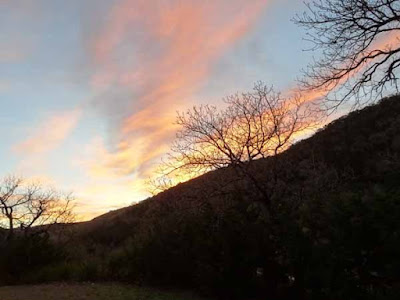Morning Sky
A few days ago we decided to drive out to the Heart of
the Hills Fisheries Science Center in Mountain Home.
It’s always fun to visit fish hatcheries. They are all different.
Water temperatures range from 60 to 75 degrees year
round. The water is from Stockman’s
Springs.
We are always on the lookout for birds. Fish
hatcheries are pretty good places to find fish eating birds!
Rare picture of an Osprey without a fish.
There was a rookery tree next to the hatchery. Rookery trees are where birds (Great Blue Herons and Great Egrets in this case) gather to build nests and raise their young. Strength in numbers! You may be able to make out two birds on/in nests (Center and lower center)
Rookery
Great Blue Heron
Heart of the Hills Fish Hatchery was originally
constructed in 1925 and operated as a production hatchery until 1969. It is now called Heart of the Hills Fisheries
Research Center and is the research arm of Texas Parks and Wildlife’s Inland
Fisheries Division.
All the ponds are filled and drained by gravity.
The day we visited, most of the 25 ponds were empty. We picked up a very informative brochure with
a map showing types of fish that are usually in the ponds. Koi, Gambusia, various species of Catfish, Sunfish,
and Large mouth Bass are some of the species in the ponds. Also 22 Alligator Gar ranging from 2 feet to
just over 7 feet long and one resident Paddlefish were supposed to be
here.
A group of Killdeer enjoyed picking bugs out of the bottom of a recently emptied pond.
A group of Killdeer enjoyed picking bugs out of the bottom of a recently emptied pond.
Killdeer
We didn’t see any fish nor did we see any helpful staff
but it was a nice place to visit and it will be fun to go back sometime when more
of the ponds are in use and possibly talk to one of the researchers. As we left we spotted a single male Ruddy Duck on a pond. Their cheeks turn white and their bill blue when they come into breeding plumage.
Ruddy Duck male
We have heard about Stonehenge II for a couple of years. It was on our way home from the fish hatchery
so we stopped by for some pictures.
In 1989, Doug Hill finished work on his back patio and
was left with one extra limestone slab.
As a joke he offered it to his friend, Al Sheppard. Sheppard stood the slab upright in the middle
of his pasture. Hill and Sheppard liked
the look so much they decided to build their very own Stonehenge.
It took about 9 months to complete and is fabricated from
steel, metal lathe, and plaster and anchored with concrete.
Stonehenge II is 90% as wide and 60% as tall as the
original. The original Stonehenge in
Wiltshire, England was erected around 2500 B.C.
After visiting Easter Island, Sheppard was inspired to
add two 13 foot tall Moai head statutes.
Sheppard passed away in 1994 and his family donated Stonehenge II and the Moai to the Hill Country Arts Foundation were it was moved in 2012.
We had a fun day and have enjoyed exploring the Texas
Hill Country!
















7 foot gar? I'd like to see one of those!
ReplyDeleteWe looked but didn't see even a small one. The information said that the group congregated in a certain area late in the afternoon, but we were there in the morning.
DeleteI have never heard of Stone Henge II, but it reminded me of Carhenge in Nebraska.
ReplyDeleteThere is a "Carhenge" type installation up in Texas panhandle was well. I guess folks will poke anything into the ground as art!
DeleteHad to retype comment, too many auto correct spelling errors.
ReplyDeleteYou sure have traveled a lot of obscure texas attractions and have found many jewels. Thanks for sharing.
Virginia
Glad you retyped your comment. We were trying to decipher the original! We’re always looking for places to visit. Stay tuned - we’re heading back to Maine soon.
DeleteLOL. We are headed back to Farragut soon.
DeleteWe had a Mountain Home in Idaho too, just outside of Boise.
ReplyDeleteI agree with Virginia about your exploring. My nickname for you two is "The Explorers".
I think that Mountain Home is just a great name for a town!
Delete